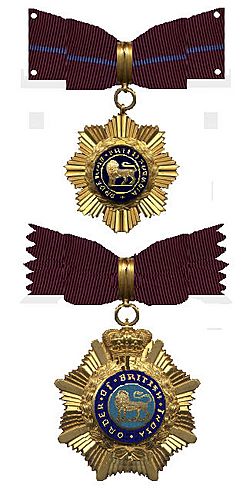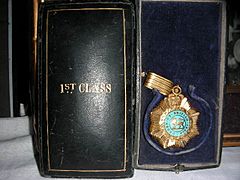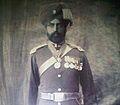Order of British India facts for kids
Quick facts for kids Order of British India |
|
|---|---|

Insignia of the Order, Second Class (above) and First Class, prior to 1939, (below)
|
|
| Type | Order of merit |
| Eligibility | Officers of the British Indian Army holding a Viceroy's commission, Indian Officers of Indian States Forces, Frontier Corps and Military Police |
| Awarded for | Long, faithful and honourable service |
| Status | No longer awarded after 1947 |
| Post-nominals | OBI |
| Statistics | |
| Established | 17 April 1837 |
| Precedence | |
| Next (higher) | Royal Red Cross (Class II) |
| Next (lower) | Kaisar-i-Hind Medal |
Ribbon 1837–1838 Ribbon 1838–1939 First Class ribbon 1939–1947 Second Class ribbon 1939–1947 |
|
The Order of British India was a special award created in 1837. It was given to soldiers in the British Indian Army for "long, faithful and honourable service." This award was first started by the British East India Company. Later, it became part of the official British awards system in 1859. The Order stopped being awarded in 1947. This was when British India became two new countries: India and Pakistan.
Contents
About the Order of British India
The Order of British India was given out by the Viceroy of India. This award recognized long, faithful, and honorable service. It was specifically for Indian officers in the British Indian Army. These officers held a special rank called "Viceroy's Commissioned Officer." While it could be given for brave actions in a battle, it was usually for officers. These officers had served for 20 to 30 years.
Why the Order Was Created
The Order was first set up by Lord William Bentinck in April 1837. Its main purpose was to honor Indian officers in the East India Company's army. At that time, Indian officers had very slow chances for promotion. Their careers mostly depended on how long they had served.
The highest level of the Order was the 1st Class. It gave the title sirdar bahadoor to 100 senior Indian officers. These officers were called subedars and risaldars. They also received a pay raise of two rupees a day. The 2nd Class was for another 100 Indian officers of any rank. They received the title bahadoor and a smaller pay raise.
In 1856, a writer named Henry Montgomery Lawrence said the Order had become "virtually the reward of old age." This meant it was mostly given to officers who were about to retire.
Changes Over Time
In September 1939, the award became open to more people. This included Indian officers in the Indian States Forces, Frontier Corps, and Military Police. In January 1944, it was expanded even further. It could then be given to Indian officers in the Royal Indian Navy. It also included the Hong Kong and Singapore Royal Artillery. Even foreign officers could receive it as honorary members.
What the Award Looked Like
The Order had two different levels, called classes. Both were worn around the neck on a ribbon.
- First Class: The badge was a gold star about 1.7 inches (43 mm) wide. It had gold rays and a blue center. In the center, it said "ORDER OF BRITISH INDIA" around a lion. A laurel wreath surrounded this, topped with a crown. Before 1939, the words were on a dark blue background. After 1939, it changed to light blue, matching the lion's background. Officers who received the First Class could use the title Sardar Bahadur (meaning "heroic leader").
- Second Class: This badge was slightly smaller, about 1.5 inches (38 mm) wide. It looked similar to the First Class badge. However, it did not have a crown. The center enamel was dark blue. Officers who received the Second Class could use the title Bahadur (meaning "hero").
People who received either class could use the letters OBI after their name. All awards started in the second class. To get the first class, you had to already be a member of the second class.
The ribbon was originally sky-blue. But in 1838, it was changed to dark red. This was because hair oil used by Indian soldiers would stain the sky-blue ribbon. From September 1939, the First Class ribbon had two thin light blue stripes near its center. The Second Class ribbon had one light blue stripe in the middle.
Notable Recipients
Many brave officers received the Order of British India. Here are a few examples:
First Class Recipients
- Sardar Bahadur Major Daud Khan, from the Alwar State Lancers. He received the 2nd class in 1897 and the 1st class in 1904.
- Sardar Bahadur Major General Bakhshish Singh OBI, Military Secretary Patiala.
- Sardar Bahadur Captain Gardhara Singh Minhas OBI, recognized for his service in the Great Wars.
- Honorary Captain Muhammad Khan, OBI (1st Class), from the 10th Baluch Regiment.
- Subedar Major Bahadur Multani Ram, OBI (First Class) 1920, a participant in World War I.
- Colonel Rao Bahadur Thakur Balu Singh ji Inderpura, OBI, IDSM (1st Class).
- Sardar Bahadur Lieutenant Raja Paindah Khan O.B.I, a chieftain from Jhelum.
- Sardar Bahadur Captain Moovera kalappa, OBI, from the 71st Coorg Rifles, for service in the WW2 Burma Campaign.
- Sardar Bahadur Raja Jeoraj Singh, a Major-General in the Bikaner State Forces.
- Khan Bahadur Major General Fateh Naseeb Khan OBI 1st Class, Commander-in-chief of Alwar State Forces.
- Honorary Captain Sardar Bahadur Bhola Singh Gulia, OBI (1st Class), from the Indian Survey Regiment.
- Subedar Major and Honorary Lieutenant Sardar Bahadur Pehlwan Khan MBE, OBI, Bronze Star Medal.
- 'Sardar Bahaudur' Honorary Captain Bakhshi Jagat Singh, OBI (1st class), a spy in Afghanistan.
Second Class Recipients
- Risaldar Nadir Ali Khan, from the 9th Hodson's Horse.
- Subedar and Honorary Captain Bahadur Inayat Ullah Asmie, OBI (2nd Class), from the 10 Baluch Regiment.
- Subedar-Major Bahadur Jagindar Singh, OBI (2nd Class), IOM (2nd Class).
- Subedar Major Purshotam Dass OBI (2nd Class) of 74th Punjabis, awarded on 16 April 1911.
- Subedar Major and Honorary Lieutenant Ram Singh Kaila, Bahadur, IOM, OBI, from the 15th Ludhiana Sikhs.
- Commandant Sardar Bahadur Narain Singh Hundal, OBI 2nd Class, from Kapurthala State Forces.
- Risaldar Mir Dad Khan Tarin of 9th Hodson Horse.
- Subedar (Hony Subedar-Major) Amar Nath Puri, Bahadur, OBI, from the Indian Medical Department.
- Risaldar Major Ganga Dat Honorary Lieutenant 2nd lancer OBI 1917 France.
Images for kids









